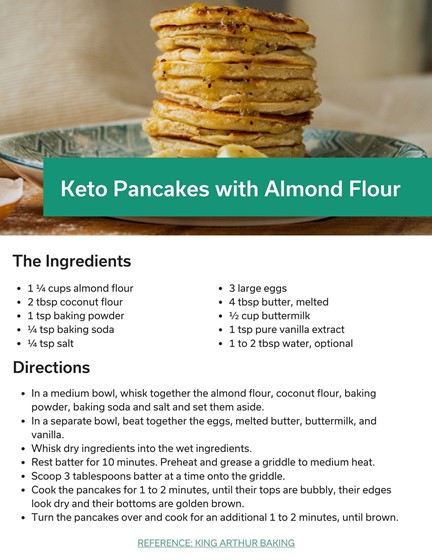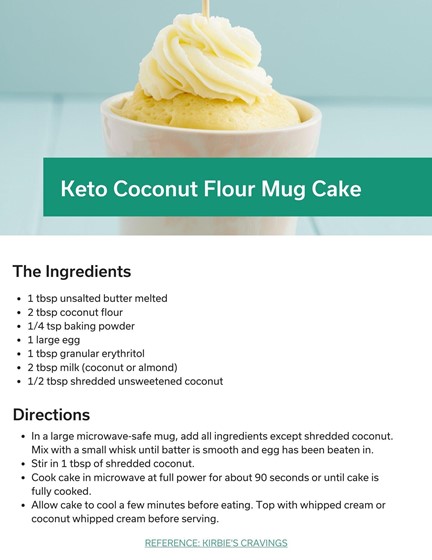How to Choose and Cook with Keto Flours

Buying flour at the grocery store used to be simple. Whether it was all-purpose flour or cake flour, the options to make your favorite cookies, bread or dessert didn’t require much effort.
Today, grocery store shelves are stocked with gluten-free flour alternatives and keto-friendly flours made from products you may not be familiar with. If you’re trying out a new diet or need low-carb alternatives for health purposes, this blog will help you learn about the various types of keto flours and how you can cook with them.
What is gluten-free flour?
Gluten is a protein found primarily in wheat and other grains (rye, barley, spelt, farro and others) that give foods structural integrity by adding a stretchy quality.
Not all grains have gluten, though. The most common examples include oats, corn, rice, amaranth and sorghum. Seeds, such as quinoa and buckwheat, are also usually lumped into this category, too.
As the prevalence of celiac disease and gluten sensitivity has grown, gluten-free flours have become more popular. Gluten-free flour is produced the same way as traditional flour from wheat – the grains or seeds are ground into a fine texture. Once ground, it can even be visually hard to differentiate flour from gluten-free flour.
What is keto flour?
Keto flour is similar to gluten-free flour in that it doesn’t contain gluten. The main difference, however, is keto flour is also low in carbohydrates. Therefore, gluten-free flour isn’t keto-friendly because of the high carbohydrate count.
Keto flour typically is more nutrient dense than gluten-free flour. Many gluten-free flour mixes contain rice, potato, corn or tapioca starch that offer minimal nutrition. Even more common gluten-free mixes that contain cassava flour or brown rice flour may be healthier for you, but they still contain moderate levels of carbs and aren’t keto-friendly.
Almond flour is one of the most versatile keto flours on the market. It can be used in savory or sweet recipes, such as breads, cookies, pancakes or cookies but can also be added to meatballs in place of traditional bread crumbs or used to bread chicken.
Foods with keto flours almost always need an added binder – in addition to eggs – so the flour won’t fall apart in the finished product. Xanthan gum or psyllium husk powder are two popular low-carb options used as binders.
Generally, keto flours can’t be used in a 1-to-1 swap for all-purpose flour, bread flour or cake flour. Because of the low levels of carbohydrates, keto flour is dense and absorbs more liquid than traditional flour (recipes usually call for more eggs or other liquids). This can affect the taste and texture of recipes when using improper measurements.
Using a mix of keto flours often results in a better final product instead of focusing on one type. For example, food manufacturers sell keto flour mixes with almond flour and coconut flour to improve the taste and texture.
Types of keto flours
Almond flour: This popular keto flour is made from blanched almonds (skins removed). Almond flour is one of the few keto flours that can be swapped 1-to-1 in place of traditional flour. Some recipes call for ¾ cup almond flour, though, since the higher fat content of almonds make the flour more dense.
Almond meal: This type is made from whole almonds, skins and all, which makes it higher in fiber. Almond meal has a coarser texture and is darker in color than almond flour. Almond meal can be used interchangeably with almond flour for cookies and other quick breads, but almond flour is preferred for cakes that need a lighter texture.
Coconut flour: This type of flour is made from ground, dried coconut meat. It is both high in fiber and protein, but it’s more dense than almond flour and soaks up liquids fast. Most recipes call for a 1-to-4 ratio. Coconut flour is a popular substitute for cookies, breads, cakes, pancakes and waffles.
Flaxseed flour: Sold as ground flaxseed, this type of powder is high in fiber and omega 3 fats. The high fiber content makes ground flaxseed turn into a gel when mixed with liquids. Ground flaxseed isn’t usually used as a main ingredient but rather a supplemental flour substitute for breads, cookies, crackers, tortilla chips and other baked goods.
Sunflower seed flour: This type of flour is made from ground sunflower seeds. Sometimes called sun flour, sunflower seed flour is high in vitamin E and omega 3 fats. It’s a popular flour swap for people with nut allergies, and it even has more protein than almond flour. Sun flour can often be used as a 1-to-1 swap for traditional flour.
Pumpkin seed flour: This type of flour is yet another alternative for people with nut allergies. Pumpkin seeds are high in protein and low in carbs. Pumpkin flour works well for muffins, pancakes, waffles and other savory fall-inspired foods.
Sesame flour: This type of flour is made from unhulled sesame seeds, which creates a high-fiber, low-carb powder. Sesame flour is another nut-free alternative that can be swapped for traditional flour. Common uses include breads and other snack foods such as crackers.
Chia seed flour: This type of flour is a good source of fiber and omega 3 fats. Like flaxseed flour, chia seed flour is considered hydrophilic, meaning they absorb water and turn into a gel. Chia seed flour is used as a supplemental ingredient for crackers, cakes, rolls and muffins.
Oat fiber: Not to be confused with oat flour, oat fiber is made from the outer shell of oats. Oat flour is high in carbs, making it not keto-friendly. But oat fiber is much lower in carbs since it contains only the hull. Oat fiber works well as a supplemental ingredient, as it adds bulk to recipes.
Lupin flour: This type of flour comes from lupin beans of the legume family and is high in fiber and protein and low in net carbs. Lupin flour can be bitter, so it’s not often used as a primary swap for traditional flour. Instead, it works well as a supplemental flour in savory dishes.
Cauliflower flour: This type of flour is made from dried cauliflower florets, stems or leaves. Unlike other seed and nut flours, cauliflower is fat free and isn’t as dense as other keto flours. It works well for savory foods such as pizza dough and breads.
Keto flour nutrition
Keto flour is almost always a healthier swap for traditional flour due to a higher amount of vitamins, minerals and fiber. Here are some examples:
2 tablespoons Almond flour
- 90 calories
- 8 g total fat
- 3 g total carbohydrates
- 1 g fiber
- 2 g net carbs
2 tablespoons coconut flour
- 70 calories
- 2 g total fat
- 10 g total carbohydrates
- 7 g fiber
- 3 g net carbs
2 tablespoons flaxseed flour
- 80 calories
- 6 g total fat
- 4 g total carbohydrates
- 4 g fiber
- 0 g net carbs
2 tablespoons sesame flour
- 115 calories
- 4 g total fat
- 11 g total carbohydrates
- 5 g fiber
- 6 g net carbs
2 tablespoons cauliflower flour
- 60 calories
- 0 g total fat
- 11 g total carbohydrates
- 6 g fiber
- 5 g net carbs
Keto flour recipes
Keto pancakes with almond flour
If you glance at the ingredients, this keto-friendly mix doesn’t look much different than traditional pancakes you’d find at the diner. Almond flour and coconut flour replace traditional flour, and the addition of extra eggs and buttermilk help keep the mixture moist. The absence of sugar also makes the recipe one you don’t have to feel guilty about eating.
Lupin and almond flour blueberry muffins
Traditional blueberry muffins sound like they’re healthy, but they’re full of carbs and added sugars. This version contains vitamins and minerals from a combination of lupin flour, almond flour, oat fiber and coconut flour. Monk fruit sweetener, a zero-calorie sugar alternative that is extracted from the juice of monk fruit, helps counterbalance the slight bitterness of lupin flour. The addition of xanthan gum helps bind the muffins and give them structure.
Keto coconut flour mug cake
Craving something sweet but don’t want to spend time baking an entire cake? This 90-second keto mug cake is an easy way to satisfy your cravings without making too much of a mess in the kitchen. To fully embrace the cake’s coconut flavor, use coconut milk and top with coconut whipped cream.
Losing weight isn’t easy, and one way to start is by cutting down the consumption of empty calories such as those from refined white flour. In the event your weight loss journey has stalled, the INTEGRIS Health Weight Loss Center offers surgical weight loss services such as bariatric surgery: gastric bypass and vertical sleeve gastrectomy. Learn more about our services today.






